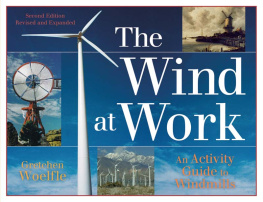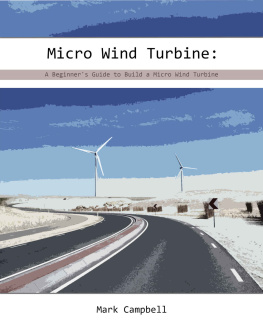
THE AUTHORS
WEATHER EXPERTS & SAILORS
David Houghton was a passionate meteorologist, spending over 30 years at the UK Met Office. He was a member of the Royal Meteorological Society since 1949. In 2000, David was awarded the Societys Michael Hunt Award for excellence in increasing the understanding of meteorology or its applied disciplines among members of the general public, including particular groups (e.g. sailors).
He worked as an advisor to Olympic, Admirals Cup, Americas Cup and Round the World Race sailing teams for over 30 years in many different parts of the world. This provided him with the wherewithal to hone and refine the concepts, arguments and rules of thumb in this book.
Davids unique double expertise as a sailor and weather forecaster makes his books invaluable aids to all sailors. Both Weather at Sea and Wind Strategy have been in print since 1986 and are regarded as classic weather texts for the cruising and racing sailor respectively.
Fiona Campbell is a successful meteorologist with a passion for the environment and a love of sailing. She graduated from the University of Reading, with her degree thesis based on a study of the winds in the Hauraki Gulf, New Zealand.
Fiona took over from David the responsibility for advising the UKs top sailing teams at Olympic, European and World regattas, as well as GBR and other Americas Cup challenges. She has also worked to help boat designers, competitors and race organisers, such as Cowes Week, to optimise their performance.
Fiona worked alongside weather legend David Houghton for many years and became co-author of Wind Strategy for the 2005 edition a book which she had loved and used herself when learning to race in the North West Scotland training squad. She has relished the opportunity to update the text again for this latest edition.
CHAPTER 1
The Wind-Wise Sailor
It has long been assumed that a helmsman competing on home waters has an advantage over a visitor because years of practice have imparted a seat of the pants appreciation of the behaviour of the local wind. The confidence of the seat of the pants sailor rests in the past. Every decision about a windshift is based on the argument it happened last time, or in the same month X years ago.
The confidence of the wind-wise sailor, on the other hand, rests in an appreciation of the causes of bends and bands in the wind whereby accumulated experience at a variety of venues increases racing skill. Because the weather demonstrates an almost infinite number of variations, there will inevitably be occasions when the seat of the pants sailor is caught out, having never seen anything like it before. The wind-wise sailor, however, will identify a reason for the unusual event and is likely to sail better through making well-founded decisions. To be right every time is hardly possible, but knowledge increases with every new observation as new pieces are added to the total picture of weather wisdom.
Although every sailing venue is different, the forces which create and control the wind are in principle the same everywhere. There is a scientific reason for every windshift and bend, and virtually all those which are important to the racing sailor can be understood by the application of basic and straightforward principles of meteorology. Taking a laptop in a racing dinghy is not an option, and numerical modelling of mesoscale wind systems in support of dinghy racing is little short of taking a sledgehammer to crack a nut.
The best and only realistic solution is the development of simple conceptual models of wind behaviour such that every reasonably intelligent sailor can recognise what is happening while racing, identify the causes of the wind patterns experienced and make informed on-the-water decisions.
Similarly with clouds: there are very many variations on the theme of lines and bands of cloud, and indeed great artists have for centuries found them a never-ending source of inspiration. For the sailor every cloud and every cloud pattern conveys a message of some sort concerning the origin, movement, and stability of the air it represents. Chapter looks at the messages which are capable of translation into tactical advice.
When David Houghton first wrote this book, National Meteorological Services did not make many detailed wind observations in coastal waters. By and large the only observers were sailors. Their observations reported following a days racing, in their log book or by word of mouth, originally formed the mainstay of this study. Increasing numbers of weather stations and availability of data on the internet has helped to repeatedly prove the basic principles David developed and which are detailed in this book.
The following chapters are a result of some 50 years of study of sailing venues all over the world, working closely with sailors involved in world-class racing from round-the-buoys to round-the-world events. Most of the basic principles are presented in terms of simple conceptual models of wind behaviour. The principles are the same in both hemispheres but the rules of thumb and the geometry of the models differ from the Northern to the Southern Hemisphere. So the main arguments are developed for the Northern Hemisphere, followed by a couple of chapters summarising the differences which apply for the Southern Hemisphere.
Large scale weather systems are explained in David Houghton & Libby Greenhalghs Weather at Sea , also published by Fernhurst Books, which includes guidance to the understanding, interpretation and construction of weather maps.
You need a weather map, not just a spot forecast from the latest app, to give an overall picture of what the gradient wind is doing and what changes are expected; a first and essential stage in deducing the finer details of what to expect during a race.

Iain Percy & Andrew Simpson: Wind-wise sailors who worked with David Houghton & Fiona Campbell
CHAPTER 10
Lakes, Mountains, Valleys &
Peninsulas
The principles outlined in Chapters , describing what happens when the land warms relative to the water, can be applied to all coastal and inland waters of any size anywhere in the world. Some analysts, trying to catalogue their observations of coastal breezes, have tried to distinguish different sorts of sea breeze, or have regarded each venue as unique, requiring individual classification. But in our experience there is just one sort of sea breeze which is generated in the same way the world over, and the one critical factor on which everything else depends is the direction and strength of the pressure gradient wind and its relation to the lie of the coast.
With the whole compass range of possible wind directions there is scope for many sea breeze situations, but all of them are capable of being understood as outlined here.
On pages we looked at examples of the generation of sea breezes on lakes, bays and island shores in the absence of a gradient wind. We now turn to what happens in the presence of a gradient wind.
Lakes
We saw on p38 that many lakes are too small to support a lake breeze onto all shores. With a gradient wind blowing across the lake there is a greater chance of finding a reasonable lake breeze because it develops onto one shore only, the one for which the gradient wind is offshore, and it is preferentially supported from the area to the left of the breeze where the diverging streamlines encourage subsidence.
Next page













